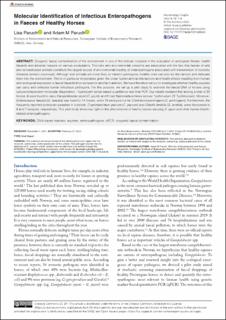| dc.contributor.author | Paruch, Lisa | |
| dc.contributor.author | Paruch, Adam | |
| dc.date.accessioned | 2022-12-27T14:09:07Z | |
| dc.date.available | 2022-12-27T14:09:07Z | |
| dc.date.created | 2022-04-19T16:42:11Z | |
| dc.date.issued | 2022-04-11 | |
| dc.identifier.citation | Microbiology Insights. 2022, 15 1-6. | en_US |
| dc.identifier.issn | 1178-6361 | |
| dc.identifier.uri | https://hdl.handle.net/11250/3039575 | |
| dc.description.abstract | Zoogenic faecal contamination of the environment is one of the indices included in the evaluation of ecological threats, health hazards and adverse impacts on various ecosystems. The risks and environmental concerns are associated with the fact that faeces of wild and domesticated animals constitute the largest source of environmental loading of enteropathogens associated with transmission of zoonotic diseases (enteric zoonoses). Although sick animals are more likely to transmit pathogens, healthy ones can also be the carriers and defecate them into the environment. This is of particular importance given the close human-animal interactions and health effects resulting from human and ecological exposures to faecal hazards from companion and farm animals. We have therefore set out to investigate whether healthy equines can carry and defecate human infectious pathogens. For this purpose, we set up a pilot study to examine the faecal DNA of horses using culture-independent molecular diagnostics – fluorescent probe-based quantitative real-time PCR. Our results revealed that among a total of 23 horses, 6 were found to carry Campylobacter jejuni (C. jejuni), and 5 had Salmonella enterica serovar Typhimurium (S. Typhimurium). Moreover, Enterococcus faecalis (E. faecalis) was found in 14 horses, while 19 were positive for Clostridium perfringens (C. perfringens). Furthermore, the frequently reported protozoan parasites in livestock, Cryptosporidium parvum (C. parvum) and Giardia lamblia (G. lamblia), were discovered in 8 and 7 samples, respectively. This pilot study shed new light on the phenomenon of healthy horses carrying C. jejuni and other human-health-related enteropathogens. | en_US |
| dc.description.abstract | Molecular Identification of Infectious Enteropathogens in Faeces of Healthy Horses | en_US |
| dc.language.iso | eng | en_US |
| dc.publisher | SAGE | en_US |
| dc.rights | Navngivelse 4.0 Internasjonal | * |
| dc.rights.uri | http://creativecommons.org/licenses/by/4.0/deed.no | * |
| dc.title | Molecular Identification of Infectious Enteropathogens in Faeces of Healthy Horses | en_US |
| dc.title.alternative | Molecular Identification of Infectious Enteropathogens in Faeces of Healthy Horses | en_US |
| dc.type | Peer reviewed | en_US |
| dc.type | Journal article | en_US |
| dc.description.version | publishedVersion | en_US |
| dc.rights.holder | © The Author(s) 2022 | en_US |
| dc.source.pagenumber | 1-6 | en_US |
| dc.source.volume | 15 | en_US |
| dc.source.journal | Microbiology Insights | en_US |
| dc.identifier.doi | 10.1177/11786361221089005 | |
| dc.identifier.cristin | 2017666 | |
| dc.relation.project | EC/H2020/817992 | en_US |
| dc.relation.project | Norges forskningsråd: 311882 | en_US |
| cristin.ispublished | true | |
| cristin.fulltext | original | |
| cristin.qualitycode | 1 | |

